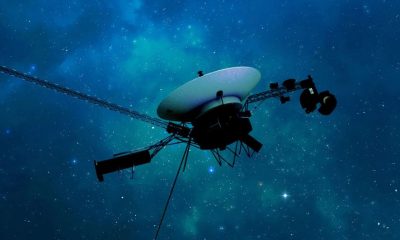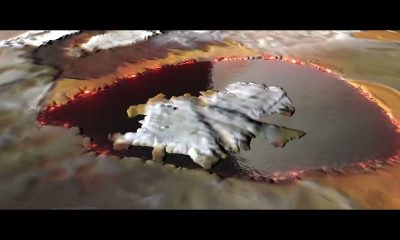News
Prepare for the Next Arrival of an Object Like ‘Oumuamua with an Interstellar Object Explorer (IOE)

On October 19th, 2017, astronomers with the Pan-STARRS survey observed an Interstellar Object (ISO) passing through our system – 1I/2017 U1 ‘Oumuamua. This was the first time an ISO was detected, confirming that such objects pass through the Solar System regularly, as astronomers predicted decades prior. Just two years later, a second object was detected, the interstellar comet 2I/Borisov. Given ‘Oumuamua’s unusual nature (still a source of controversy) and the information ISOs could reveal about distant star systems, astronomers are keen to get a closer look at future visitors.
For instance, multiple proposals have been made for interceptor spacecraft that could catch up with future ISOs, study them, and even conduct a sample return (like the ESA’s Comet Interceptor). In a new paper by a team from the Southwest Research Institute (SwRI), Alan Stern and his colleagues studied possible concepts and recommended a purpose-built robotic ISO flyby mission called the Interstellar Object Explorer (IOE). They also demonstrate how this mission could be performed on a modest budget with current spaceflight technology.
The study was conducted by Alan Stern, the Principal Investigator for NASA’s New Horizons missions, and his colleagues at the Southwest Research Institute (SwRI) in Boulder, Colorado. This included Principal Scientist Silvia Protopapa, manager Matthew Freeman, researcher/director Joel Parker, and systems engineer Mark Tapley. They were joined by Cornell Research Associate Darryl Z. Seligman and Caden Andersson, a researcher with Colorado-based company Custom Microwave Inc. (CMI). Their paper appeared on February 5th, 2024, in the journal Planetary and Space Science.

Interstellar Objects (ISOs) Abound!
Since ‘Oumuamua first buzzed our system, scientists have assigned a high value to ISOs, which represent material ejected from other solar systems. By obtaining samples and studying them up close, we could learn much about the formation of other stars and planets without actually sending missions there. We could also learn a lot about the interstellar medium (ISM) and how organic material, and maybe even the building blocks for life, are distributed throughout the galaxy (aka. Panspermia Theory). As they state in their paper:
“ISOs represent the leftovers from the formation of planetary systems around other stars. As such, their study offers critical new insights into the chemical and physical characteristics of the disks from which they originated. Additionally, a comprehensive analysis of their composition, geology, and activity will shed light on the processes behind the formation and evolution of planetesimals in other solar systems.
“Close encounters with small bodies in our solar system have vastly enhanced our understanding of these objects, contextualized our ground-based observations, and advanced our knowledge of planetesimal formation models. Similarly, a close flyby of an ISO promises to be equally transformative. It stands as the logical next step in exploring the early history of both our Solar System and exoplanetary systems.”
Moreover, population studies of ISOs have indicated that about seven pass through our Solar System every year. Meanwhile, other research has shown that some are periodically captured and are still here. With next-generation instruments becoming operational, scientists anticipate that there will be a significant increase in the rate of ISO discoveries in the late 2020s and the 2030s. This includes the Vera C. Rubin Observatory currently under construction in Chile, which is expected to gather its first light in January 2025.
Researchers anticipate the observatory will gather data on more than 5 million Asteroid Belt objects, 300,000 Jupiter Trojans, 100,000 near-Earth Objects (NEOs), and more than 40,000 Kuiper Belt objects. They also estimate that it will detect about 15 interstellar objects in its first ten-year run, known as the Legacy Survey of Space and Time (LSST) – though other estimates say up to 70 ISOs a year. For their study, Stern and his colleagues assume that any ISOs within a distance of about twice the distance between Earth and the Sun (2 AU) would be bright enough to be detectable by the LSST.

Objectives and Instruments
As Stern and his colleagues explain in their paper, their proposed IOE would have two main science objectives. These include determining the “composition of the ISO to provide insights into its origin and evolution.” As noted, these studies would provide invaluable information on the initial conditions of the ISO’s host solar system. In this respect, the IOE would provide information similar to what the New Horizons mission revealed about the Kuiper Belt Object (KBO) Arrokoth or how the ESA’s Rosetta mission detected the building blocks of life in the comet 67P/Churyumov–Gerasimenko.
Second, the IOE would determine or constrain the “nature, composition, and sources of the ISO coma activity and determine the processes responsible for [the] observed activity.” Typically, coma activity results from ice sublimating as objects approach a star, which releases dust grains and refractory organic molecules from the nucleus. As previous observations have shown, the activity of comets depends on solar heating and the comet’s own physical characteristics. As Stern and colleagues expressed in their paper:
“By characterizing the composition and spatial distribution of an ISO’s coma, IOE can directly determine the primary components of its target ISO, identify the mechanisms behind coma activity, and deepen our insights into the composition and processes extant in its protoplanetary formation disk, where planetesimals like it were forming… Furthermore, comparing the physical properties (i.e., the chemical composition, size distribution, type of mixing) of ices and refractories in the coma with those on the surface can provide insights into potential processes that may have modified the surfaces.”
Based on these science objectives, Stern and his colleagues listed what instruments the IOE would need. These include:
- A panchromatic visible-wavelength imager with arcsecond-class angular resolution and high dynamic range
- A visible-wavelength imager with three filters (min) and an infrared imaging spectrometer that spans the 1–2.5 um wavelength range (possibly up to 4 um) with a resolving power of at least 100
- An ultraviolet (UV) spectrometer spanning the wavelength range of 700–1970 angstrom (Å) with a spectral resolution of equal or greater than 20 Å
- A panchromatic visible-wavelength imager and UV and infrared imaging spectrometers

Mission Profile
Next up is the design of the spacecraft itself, which is dictated by the ephemeral nature of ISOs. As ‘Oumuamua and Borisov demonstrated, the velocity of ISOs means that they are likely to remain undetected until they are close to the inner edge of the Main Asteroid Belt. In addition, their hyperbolic trajectories mean that they are likely to zip around our Sun and become unreachable shortly after they are detected. Last, there’s the positioning of the intercept mission itself, which directly affects the spacecraft’s ability to deploy and reach the target ISO.
For their study, Stern and his team selected a “storage orbit” location at the Earth-Moon L1 Lagrange Point, located between the Earth and Moon. This location has several advantages, most notably how a spacecraft positioned will need to generate very little thrust to achieve escape velocity – meaning that most of its available acceleration (delta-v) will be put towards its intercept trajectory. This storage orbit also means less propellant and less time is needed to get underway, and allows for a quick gravitational assist from a near-Earth flyby.
For their study, Stern and his team set a detectability limit of 2 AU and simulated ISOs with a mean velocity of 32.14 km/s (~20 mps) and a closest solar approach of 10 AU or less. Other constraints that were considered included the positions of the Earth and ISO at the time of its detection, the ISO’s orbit parameters, the maximum distance that a mission could intercept an ISO (aka. the “heliocentric radius of intercept”), and the relative velocity between the spacecraft and ISO. To effectively analyze this data, the team generated an algorithm to optimize the intercept trajectory and establish a small subset of ISOs that could feasibly be intercepted.
They simulated all of these calculations over a period of 10 years and (using previous missions as precedents) derived several key parameters. As they established, the mission would need to be capable of an acceleration (delta-v) of 3.0 km/s, establish a minimum flyby altitude of 400 km (~250 mi), intercept the ISO within 3 AUs of the Sun, and achieve a flyby velocity of 100 km/s (62 mps). With this “detectability sphere” established, they found that the chances for a successful intercept increased considerably at higher velocities – 3 to 3.9 km/s (1.86 to 2.4 mps) – and at distances closer to 3 AU.
The study of ISOs is a burgeoning field of astronomical research encompassing next-generation observatories (like Vera Rubin) and proposed intercept missions. In addition to the IOE, similar concepts have been proposed since the detection of ‘Oumuamua and 2I/Borisov – including Project Lyra, a proposal made by the Institute for Interstellar Studies (i4is). While such a mission may be years from realization, detailed studies such as this will help inform the next phase of development – the designing and testing of mission concepts themselves.
Stern and his colleagues acknowledge that more research is needed before this can happen but emphasize that their work is an important first step. “More detailed work will be needed next to better prepare the mission concept to be proposed to a future NASA mission opportunity,” they write, “but this report provides the mission’s basic objectives, key requirements, and attributes as a starting point.”
Further Reading: Planetary and Space Science
News
Facing Criticism for Shooting Dog, South Dakota Governor Noem Discusses ‘Difficult Choices’

South Dakota Governor Kristi Noem found herself in hot water recently after admitting to shooting her “untrainable” hunting dog. The controversial incident sparked public outrage, but it did not stop her from attending a gathering of California Republicans, where she received a warm reception on Saturday.
Noem, known for her stance on gun rights and conservative leadership, addressed more than 200 people at the California Republican Party convention in Burlingame. She emphasized the importance of patriotism and preserving American values amidst challenging times.
Although she did not directly reference the dog-shooting incident in her speech, she alluded to the controversy surrounding her decision to euthanize her dog named Cricket due to its poor hunting skills and an unfortunate incident involving farm chickens.
Attendees at the luncheon received a copy of Noem’s book, “No Going Back: The Truth on What’s Wrong With Politics and How We Move America Forward,” which she promoted during her remarks. Despite the backlash, she remained firm in her convictions.
South Dakota Gov. Kristi Noem speaks at the California Republican Party Spring Convention on Saturday in Burlingame, Calif.
(Loren Elliot / For The Times)
Noem’s focus shifted to her leadership in South Dakota, particularly her handling of the COVID-19 pandemic and her decision to deploy the state’s National Guard to the U.S.-Mexico border. She raised concerns about drug cartels exploiting Native American tribal lands in her state and criticized the federal government for its inaction.
Despite the controversy surrounding her, Noem commended former President Trump for his authenticity and unwavering commitment to his beliefs. She highlighted Trump’s unconventional approach to politics as a sign of his genuine character.
State Republican Party delegate Anna Bryson expressed admiration for Noem’s financial policies and tax reduction efforts. She acknowledged the dog-shooting incident but credited Noem for her commitment to sound fiscal management.
South Dakota Gov. Kristi Noem speaks at the California Republican Party Spring Convention on Saturday in Burlingame, Calif.
(Loren Elliot / For The Times)
The convention, attended by over 800 delegates and guests, marked a significant gathering for California Republicans. Despite past protests during Trump’s appearance in Burlingame in 2016, the event with Noem proceeded smoothly with no major disruptions.
Noem’s resilience amidst adversity and her unwavering commitment to her principles garnered both admiration and scrutiny at the California Republican Party convention.
Times staff writer Anabel Sosa contributed to this report.
-

 Entertainment7 days ago
Entertainment7 days agoOlivia Munn opens up about her decision to have a full hysterectomy during breast cancer fight: ‘It was the right choice for me’
-

 News7 days ago
News7 days agoUniversity of Wisconsin-Milwaukee and Protesters reach an agreement to dismantle encampment
-

 News14 hours ago
News14 hours agoFacing Criticism for Shooting Dog, South Dakota Governor Noem Discusses ‘Difficult Choices’
-

 Entertainment14 hours ago
Entertainment14 hours agoSimone Biles Emerges Victorious over Suni Lee and Gabby Douglas at Gymnastics Classic













